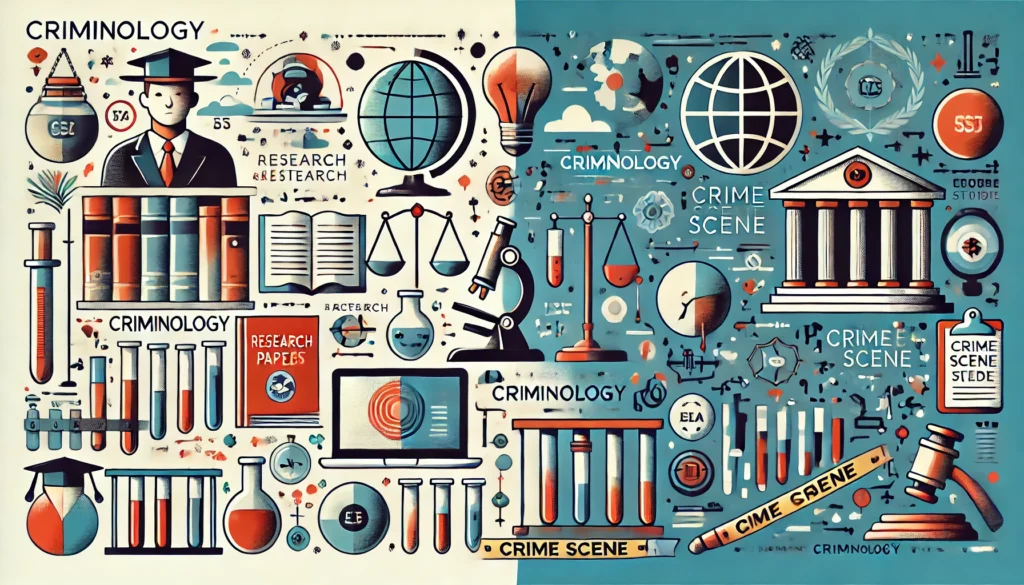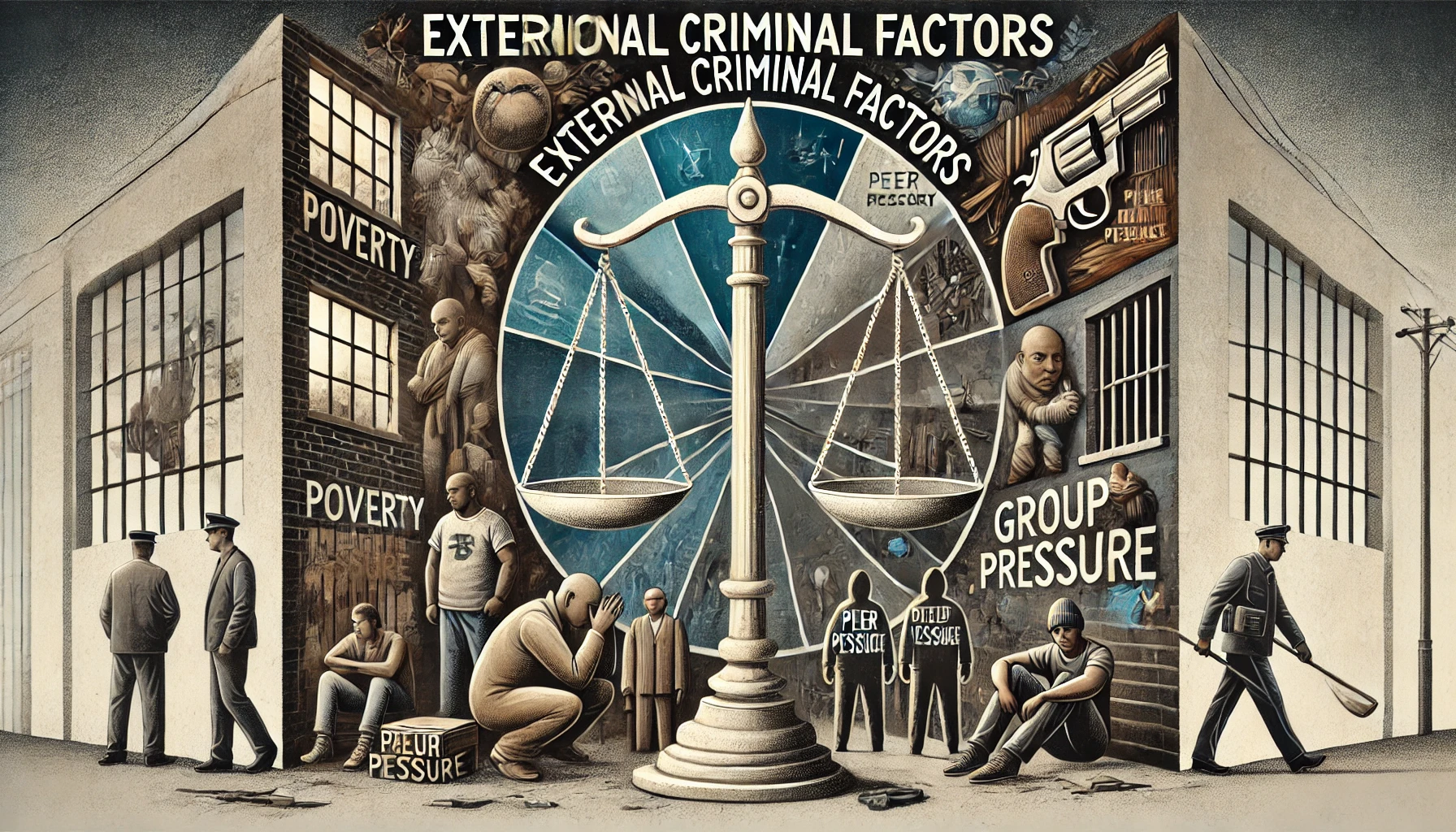Introduction
Criminology examines criminal behavior from various perspectives to understand its causes and evolution, aiming to reduce crime rates in society. One of the core aspects of this study involves external factors influencing criminal activity. These factors are considered external because they are tied to the individual’s surrounding environment rather than being under their direct control. This article analyzes these external factors in two main sections: natural factors and social factors, exploring how each contributes to shaping criminal behavior.
First Section: Natural Factors
1. Climate and Its Effect on Crime
The relationship between climate and human behavior has long been recognized. Weather conditions can directly or indirectly impact individual moods and actions.
- Heat and Violent Crimes: Research suggests that violent crimes, such as assaults and homicides, increase during hotter months. High temperatures are believed to escalate tension and irritability.
- Case Study: A University of California study revealed a 2-3% rise in violent crimes for every 1°C increase in temperature, particularly in densely populated areas.
- Cold Weather and Property Crimes: In cold regions, individuals may resort to theft to fulfill basic needs like food and shelter, especially during harsh winters.
2. Natural Disasters
Natural disasters such as earthquakes, floods, and hurricanes can create chaotic environments that encourage criminal behavior.
- Looting During Disasters: Disasters often lead to a breakdown in law enforcement, resulting in widespread looting and theft.
- Forced Migration and Crime: Disasters displace populations, increasing the likelihood of conflicts and criminal activities in resource-stressed regions.
- Example: The aftermath of Hurricane Katrina in New Orleans saw a spike in looting and robberies due to law enforcement collapse.
3. Geographical Distribution of Crime
Geography significantly shapes crime patterns:
- Urban vs. Rural Areas: Urban areas with high population densities generally experience higher crime rates than rural areas due to increased opportunities and social tensions.
- Remote Areas and Organized Crime: Remote regions are often exploited by criminal organizations for illicit operations like drug trafficking.
4. Climate Change and Crime
Long-term climate changes, such as droughts or desertification, can exacerbate economic and social challenges, leading to increased criminal activities.
- Mass Migration: Prolonged droughts force people to migrate, creating demographic shifts that strain resources and spark conflicts.

Second Section: Social Factors
1. Poverty and Unemployment
- Poverty as a Driver of Crime: Poverty is a primary factor pushing individuals toward criminal behavior, often to meet basic needs or improve living standards.
- Global Statistics: According to the United Nations, approximately 9% of the world’s population lives in extreme poverty, with property crimes being prevalent in such areas.
- Unemployment’s Role: The lack of job opportunities can lead to frustration and hopelessness, driving individuals toward illegal activities like theft or drug dealing.
2. Family Disintegration
- The Role of Stable Families: Family stability is crucial in preventing criminal behavior. However, family breakdowns, such as divorce or absentee parenting, increase the likelihood of delinquency.
- Study: Research in the American Journal of Sociology showed that children from broken families are 40% more likely to engage in criminal activities compared to those from stable homes.
- Domestic Violence: Exposure to violence within the household can instill aggressive tendencies in children, making them more prone to criminal actions.
3. Education and Culture
- Education as a Deterrent: Education fosters an understanding of laws and moral values. However, limited education correlates with higher crime rates, as individuals face fewer economic opportunities.
- Example: Those without basic education are more likely to engage in unlawful activities.
- Subcultural Influences: In certain neighborhoods, gang culture promotes criminal behavior as a means to gain social status or economic independence.
4. Media Influence
- Traditional Media and Crime: Repeated portrayal of crimes in movies or television can desensitize viewers, especially youth, to criminal behavior.
- Digital Media and Cybercrime: The internet has facilitated new forms of crime, such as financial fraud, cyberattacks, and extortion.
- Statistics: According to the Internet Crime Complaint Center (IC3), cybercrimes increased by 300% between 2019 and 2022.
Strategies to Mitigate the Impact of External Criminal Factors
1. Awareness and Education
- Public Campaigns: Launching targeted awareness programs in high-risk communities to emphasize the risks of crime and the importance of law-abiding behavior.
- Vocational Training: Offering educational and vocational training programs to provide economic opportunities for the youth.
2. Improving Infrastructure
- Economic Development: Strengthening local economies in impoverished areas to combat poverty and unemployment.
- Disaster Shelters: Establishing fortified shelters to prevent chaos and crime during natural disasters.
3. Enhancing Law Enforcement
- Community Policing: Strengthening police presence in urban and rural areas to maintain order.
- Technology Use: Employing advanced technology for crime monitoring and prevention, such as surveillance systems and data analytics.
Conclusion
Analyzing external criminal factors reveals that criminal behavior is deeply tied to an individual’s environment, both natural and social. Addressing these factors requires a comprehensive approach that integrates social, economic, and political solutions. By fostering awareness, improving living conditions, and enhancing law enforcement capabilities, societies can create safer and more stable environments for their citizens.

